Blog
Designing Social Networks For Young Behavioral Healthcare Patients
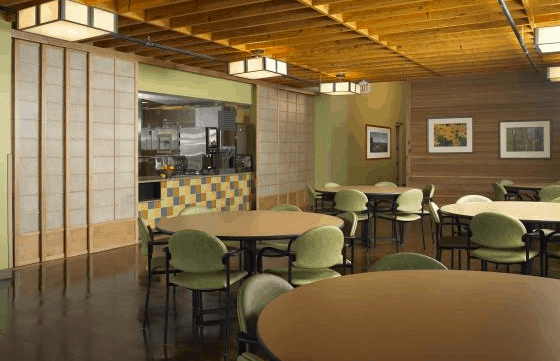
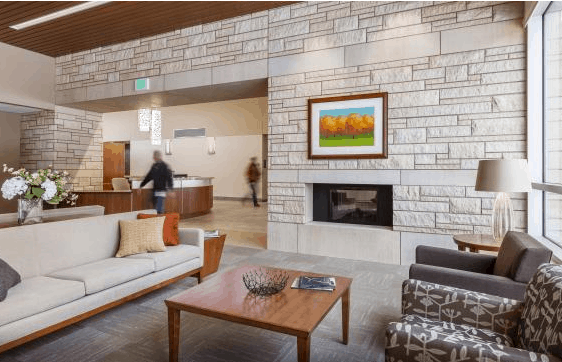
The waiting area at the Hazelden Plymouth site provides a comfortable lounge environment with a fireplace and wraparound exterior views to the park-like campus. From the waiting area, patients can access counselor offices, group rooms, and classrooms for computer training, art, and music. Photo: Paul Crosby Photography.
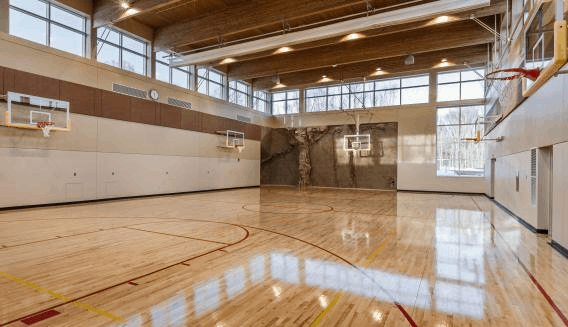
The gymnasium at Hazelden’s Plymouth campus supports many activities for patients to unwind or become involved in more structured group activities. The basketball areas can be divided for multiple games and a climbing wall used for trust-building activities is provided at the far end. The gym can also be used for large public and non-public functions. Photo: Paul Crosby Photography.
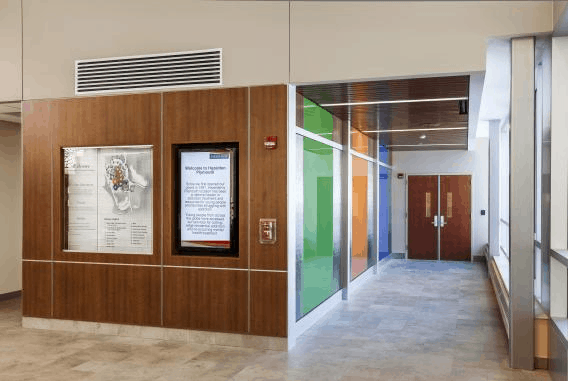
Upon entering the main reception area at Hazelden’s Plymouth, Minn., campus, a message monitor provides a welcome to visitors and information on upcoming events. The corridor, which leads to a gymnasium beyond, features back-painted glass panels that illustrate patients’ unit colors. Photo: Paul Crosby Photography.
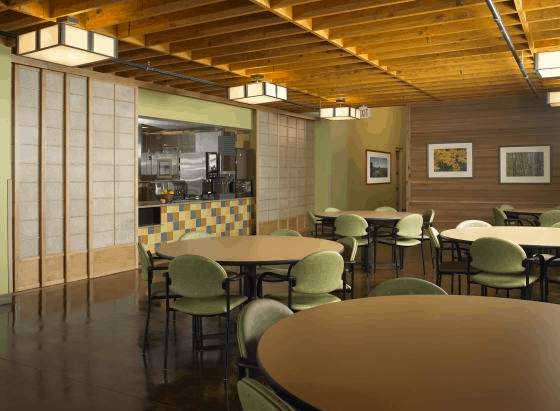
Outside of each unit is a team graffiti wall (left) where patients are invited to express their thoughts, feelings, or words of advice. The graffiti wall uses the unit color as the prominent color, with the other team colors represented, as well. Photo: Paul Crosby Photography.
The following post was originally featured in Healthcare Design Magazine and may be seen here.
Clinical approaches to behavioral healthcare treatment have evolved over the past couple of decades. Although still challenged by a negative social stigma, substance addiction and mental illness today are more often viewed as manageable diseases than character flaws. As such, the design of treatment centers has evolved, too, to support new approaches to treatment and evolving social attitudes.
Once relegated to leftover spaces within a hospital ward, today’s treatment centers are shedding their institutional look to support more welcoming environments that promote patients’ emotional, psychological, and physical well-being.
Following suit, today’s re-imagined adolescent treatment centers help take the stigma out of substance-abuse care. Whatever the size, these centers are more retreat, respite, and recovery than institutional healthcare centers. Designs address the developmental needs of teenage patients while keeping in mind the different trends in substance abuse among this age group. The two key approaches to these facilities’ success are a residential, homelike style of architecture and shared spaces for creativity, communication, and collaboration among residents.
Care in action
Two recent residential treatment centers reflect this evolving approach to behavioral health by creating a feeling of respect through design. Each assumes a holistic approach to treatment, in which patients take charge of their healing process through individual and team-based care in a supportive, nurturing environment.
The Adolescent Treatment Center of Winnebago (ATCW) for United Hospital District in Winnebago, Minn., was designed to meet adolescent healthcare needs in a rural county south of Minneapolis. Completed in August 2010, the center reflects the area’s agrarian architecture and landscape while offering a healing environment for young adults with chemical/alcohol addictions.
Located within a quiet residential area, the LEED-certified, 19,450-square-foot, single-story building is clustered into three architectural components that house administrative offices, educational and group-treatment programs, and an overnight dormitory with sleeping rooms for 24 adolescents.
The client did not want an institutional feel, instead opting for nonthreatening features that recall home and evoke a sense of calm and safety for patients who may stay at the facility for several weeks. Gabled architectural forms with cedar siding, pitched roofs, and traditional windows establish a familiar residential setting on a landscaped campus that includes a sand volleyball court, basketball court, and courtyard. The interior continues the residential character with comfortable furnishings, soothing earth tones, and abundant daylight through large windows.
On another campus, Hazelden took a similar residential approach as the ATCW when expanding its Plymouth, Minn., site dedicated to addiction treatment services for adolescents and young adults ages 12 to 25. Located on a 15-acre campus near a residential area, a 49,000-square-foot expansion (completed fall 2012) and current renovation (slated for a spring 2014 completion) includes a new 32-bed unit for female patients to increase total male/female facility capacity from 75 to 107 beds, new indoor recreation space, redesigned admissions area, and designated space for family programs and mental health services.
While the ATCW project was geared toward a regional patient base, Hazelden attracts patients from a national market. Many of the patients travel far from their homes and often experience anxiety due to coping with their disease and being uprooted from family. As such, the facility is designed to help lessen anxiety. Resident patients enter a light-filled lobby trimmed with warm colors, cherry wood, and natural local limestone. An adjacent lounge provides comfortable seating surrounding a fireplace, along with views to the outdoors.
Taking back control
Because young people rely on social interaction and time with friends to establish a sense of well-being and connection, this new breed of treatment centers encourages accountability and fellowship among patients, creating a peer-driven milieu that reinforces sharing and healing. The architecture and interior design of both facilities were crafted to support group activities and promote networks for young patients.
ATCW and Hazelden both have shared bedrooms to encourage patient accountability and interaction, and a variety of community spaces—from outdoor and indoor recreation areas to lounges, study areas and game rooms—that help promote and sustain the healing process. At Hazelden, for instance, the bedrooms (which are grouped into individual patient units containing four shared bedrooms each) connect to a community area with kitchenette and dining tables; a light-filled open lounge with fireplace, television, seating and video gaming; and outdoor patio and walking paths. There is also a meditation room that offers contemplative privacy while an exercise room and gym with basketball court and climbing wall encourage group and individual exercise. Likewise at the ATCW, the sleeping rooms open to a community lounge, study area, and game room to encourage group support.
The facilities also include private and group counseling rooms with residential furnishings that create a comfortable atmosphere, and full-service dining room where residents eat home-cooked meals at round tables that inspire camaraderie and conversation. Both facilities additionally contain flexible spaces for outpatient services.
The homelike features in each facility are balanced with high-security measures that ensure patient safety, including 24/7 monitoring systems, door alarms, and tamper-proof hardware on desks, doors, showers, and lighting. Moreover, the common spaces inspire encouragement as well as self-monitoring, so that patients grow to support one another.
Home away from home
Overall, behavioral healthcare is on track with the rest of the healthcare industry: Continuous pressure to lower costs, streamline operations, and improve patient outcomes is inspiring owners to look for new ways to deliver care and enhance the healing process. Designing treatment facilities that have a home-like setting—and emphasize personal pride and individual dignity—are a catalyst for improving healthcare practices and enabling patients to take control of their own healing process.







